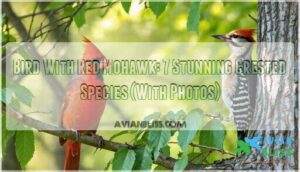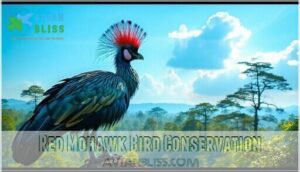This site is supported by our readers. We may earn a commission, at no cost to you, if you purchase through links.

The Northern Cardinal male flaunts a brilliant crimson crown he raises during territorial displays, while the Pileated Woodpecker shows off its striking scarlet crest as it hammers tree bark.
Other standout species include the Red-crested Turaco from Africa with its vibrant plumage, the Wood Duck’s iridescent reddish crest, and the Great Crested Flycatcher’s rusty-red mohawk.
These dramatic crests aren’t just for show—they’re powerful communication tools used for attracting mates and establishing dominance.
Each species has developed unique behavioral patterns that make their red mohawk displays even more fascinating, showcasing their ability to use these crests for attracting mates and establishing dominance with their unique behavioral patterns.
Table Of Contents
- Key Takeaways
- Birds With Red Mohawks
- Red Mohawk Bird Species
- Crested Bird Characteristics
- Red Crested Bird Behavior
- Red Mohawk Bird Conservation
- Frequently Asked Questions (FAQs)
- Where Do Royal Flycatchers Live?
- What Is The Bird With A Yellow Mohawk?
- What Bird Has An Orange Mohawk?
- What bird has a red mohawk?
- Is it rare to see a Red-headed Woodpecker?
- Are there red-bellied woodpeckers in Ontario?
- What bird of prey has a mohawk?
- Do red mohawk birds lose their crests during molting?
- Which red crested birds are easiest to attract?
- How long do red mohawk birds typically live?
- Conclusion
Key Takeaways
- You’ll recognize several species with striking red crests – Northern Cardinals display brilliant crimson crowns, Pileated Woodpeckers sport dramatic scarlet mohawks, and Wood Ducks show iridescent reddish crests
- These red mohawks aren’t just decorative – they’re powerful communication tools that birds use for attracting mates, establishing territorial dominance, and signaling emotions during social interactions
- Each species has unique feeding and habitat preferences – Cardinals prefer seeds at backyard feeders, Pileated Woodpeckers hunt insects in mature forests, and Wood Ducks forage in wooded swamps and shallow lakes
- Conservation efforts are crucial for their survival – habitat loss, climate change, and pollution threaten 75% of red-crested bird environments, making forest restoration and wildlife preservation essential for protecting these magnificent species
Birds With Red Mohawks
When you spot a bird with a striking red mohawk-like crest, you’re likely observing one of nature’s most eye-catching avian species.
These distinctive feathered crowns serve multiple purposes, from attracting mates to communicating emotions and establishing territorial dominance.
Northern Cardinal Description
You’ll spot the Northern Cardinal’s distinctive red mohawk instantly – it’s North America’s most recognizable crested bird.
Males display brilliant scarlet Cardinal Plumage while females show brown tones with coral highlights, both featuring that signature triangular red crest.
Key Northern Cardinal features:
- Red crested bird status with triangle-shaped crest variations
- Beak Color ranges from bright coral-red to orange-red
- Feather Texture appears smooth and sleek across the body
- Song Patterns include clear whistles and "birdy-birdy" calls
- Red headed bird males contrast sharply with brownish females
Pileated Woodpecker Characteristics
You’ll recognize the Pileated Woodpecker by its striking black and white stripes and flaming red crest that stands tall like a mohawk.
Nature’s most dramatic crown – a blazing red mohawk that commands attention from every forest visitor.
This impressive bird with red mohawk** measures 16-19 inches long with a 26-30 inch wingspan.
These redheaded birds inhabit mature forests across eastern North America, creating rectangular holes in dead trees for Pileated Woodpecker nesting sites while searching for carpenter ants in their specialized Pileated Diet.
Red-crested Turaco Features
The red-crested turaco stands apart from North American species with its striking royal blue plumage and brilliant red crest.
You’ll find this African beauty in sub-Saharan forests, where its vibrant feather color helps attract mates.
Unlike the pileated woodpecker’s pointed beak function for drilling, the turaco’s curved bill perfectly handles fruit.
This red mohawk bird doesn’t follow typical bird migration patterns, staying year-round in its turaco habitat.
The unique crest of the red-crested turaco is a key aspect of its mohawk maintenance and overall health.
Red Mohawk Bird Species
When you’re searching for birds with striking red crests, you’ll discover several species that showcase this vibrant feature in different ways.
These red-crested birds range from common backyard visitors to exotic woodland dwellers, each displaying unique combinations of red mohawk-style plumage with distinctive body colors and patterns.
Wood Duck Identification
You’ll instantly recognize Wood Duck males by their striking iridescent green and purple heads topped with a distinctive red mohawk-like crest.
Their bright red eyes and colorful red, yellow, and black beaks make identification easy.
Look for their webbed feet and watch for them in wooded swamps and shallow lakes.
This bird with red mohawk prefers Duck Habitat with tree cavities near water.
Their unique Feather Patterns and vibrant Beak Color distinguish them from other waterfowl along Migration Routes.
Great Crested Flycatcher Habitat
You’ll find the Great Crested Flycatcher thriving in deciduous and mixed forests across eastern North America.
This bird with red mohawk prefers mature woodlands with plenty of tree cavities for Flycatcher Nesting. Unfortunately, Habitat Loss threatens these crested bird species as Forest Ecology changes impact their homes.
During Bird Migration, they travel to Central and South America, making their Conservation Status vulnerable to environmental shifts affecting red crested species and bird habitats.
The Great Crested Flycatcher’s population stability is attributed to successful conservation efforts.
Crimson-crested Woodpecker Distribution
You’ll find this amazing red mohawk bird across vast tropical regions, from Panama through nearly every South American country except Chile and Uruguay.
The Crimson-crested Woodpecker dominates the Amazon Basin, where these striking red crested species navigate through forests, open woodlands, and forest edges.
Their flight patterns take them across diverse habitats, making tree selection essential for their widespread nesting habits.
The woodpeckers’ diet consists mainly of wood boring insects and other invertebrates found in dead trees.
Crested Bird Characteristics
You’ll notice these red-crested birds share three key physical traits that make them instantly recognizable in the wild.
Their crest shape ranges from the pointed triangular crown of cardinals to the dramatic mohawk-style plumes of woodpeckers, while their vibrant red coloration varies from deep scarlet to bright crimson accents against contrasting body feathers.
Crest Shape and Size
How dramatically do crest dimensions vary across red mohawk species?
From the Great Crested Flycatcher’s small, rounded feather texture to the Pileated Woodpecker’s impressive wedge-shaped crown, crest length ranges from subtle to spectacular.
These crested bird types showcase diverse head shape adaptations, with beak size often correlating to crest prominence in red feathered bird species, highlighting the importance of beak size.
Plumage Coloration
Beyond the striking red mohawk bird crests, you’ll discover remarkable plumage textures and color schemes that make these red feathered bird species truly enchanting.
Feather patterns range from the cardinal’s solid scarlet to the pileated woodpecker’s bold black-and-white stripes with red headed species displaying intricate combinations.
Each bird with red crest showcases unique bird red plumage variations, from glossy to matte finishes, creating stunning visual contrasts.
The vibrant colors and patterns of these birds are a result of their bright plumage characteristics, which play a vital role in their survival and mating habits.
Beak Shape and Color
You’ll notice beak shapes and colors vary dramatically among red-crested species, serving specific feeding purposes.
The Redcrested Turaco sports a sturdy yellow bill perfect for fruit crushing, while the Red-Whiskered Bulbul displays a slender black beak for insect catching.
Key beak characteristics include:
- Bill Shapes range from pointed (woodpeckers) to curved (cockatoos)
- Beak Colors span yellow, black, and orange tones
- Beak Texture varies from smooth to ridged surfaces
These adaptations match each bird’s diet and habitat needs perfectly.
Red Crested Bird Behavior
You’ll notice that red-crested birds display fascinating behaviors that go far beyond their striking appearance.
Their vibrant crests serve as communication tools during courtship displays, while their feeding habits and social interactions reveal complex patterns that vary substantially between species, showing complex patterns.
Mating and Courtship
Red crested birds show off elaborate courtship displays to win mates.
You’ll witness dramatic head movements, wing spreading, and vocal performances that showcase their vibrant plumage.
These ritual behaviors help establish pair bonding between compatible partners during breeding season.
| Species | Courtship Display | Breeding Season |
|---|---|---|
| Northern Cardinal | Males feed females seeds | March-September |
| Pileated Woodpecker | Drumming on hollow trees | April-July |
| Red-whiskered Bulbul | Territorial singing flights | Year-round (tropics) |
| Wood Duck | Head bobbing and preening | April-August |
The provided table outlines the courtship displays and breeding seasons of various bird species, including the Northern Cardinal, Pileated Woodpecker, Red-whiskered Bulbul, and Wood Duck, highlighting their unique breeding season characteristics.
Foraging and Diet
When hunting for food, each bird with red mohawk displays unique feeding strategies.
Seed consumption dominates the Northern Cardinal’s diet, while the Pileated Woodpecker excels at insect hunting through bark excavation.
Red mohawk bird species like Wood Ducks combine fruit foraging with aquatic plant consumption.
Berry eating supplements many red feather bird diets seasonally, and nut gathering provides essential fats for winter survival.
Understanding bird behavior feeding patterns is vital to appreciating the diverse foraging techniques employed by these species, which is key to their unique feeding strategies.
Social Interaction
You’ll notice that red-mohawked birds exhibit fascinating social patterns that strengthen their survival and breeding success.
These crested species display complex Group Dynamics through various behaviors:
- Flock Behavior – Cardinals and Red-whiskered Bulbuls form mixed-species feeding groups
- Bird Communication – Crest positioning signals dominance and territorial boundaries
- Social Learning – Young birds copy foraging techniques from experienced flock members
- Mate Selection – Males display crests during competitive courtship displays
- Mating Rituals – Synchronized head movements reinforce pair bonds during breeding season
The behaviors listed above are crucial for the birds’ social structure and development.
Red Mohawk Bird Conservation
You’ll find that several red-crested bird species face serious conservation challenges from habitat loss and climate change.
Understanding these threats helps you support the conservation efforts that protect these magnificent mohawked species for future generations, which is crucial for their survival and involves addressing issues like climate change.
Threats to Red Crested Birds
Unfortunately, these stunning red-crested species face mounting challenges.
You’ll witness devastating Habitat Loss as deforestation eliminates 75% of their environments. Climate Change disrupts migration patterns in 70% of populations, while Pollution Effects reduce reproductive success by 35%. Human Threats from invasive predators increase mortality rates by 50%.
Even RedWhiskered Bulbul and Redcrested Turaco populations show concerning Extinction Risks. Conservation efforts rely on effective bird conservation strategies to mitigate these threats.
| Threat Category | Primary Impact |
|---|---|
| Habitat Loss | 75% habitat elimination globally |
| Climate Change | 70% altered migration timing |
| Pollution Effects | 35% decreased breeding success |
Habitat Preservation
Protecting bird with red mohawk species requires strategic habitat preservation through thorough forest restoration and ecosystem management.
Wildlife conservation efforts focus on maintaining diverse environments that support these striking red mohawk species.
Essential habitat protection strategies include:
- Forest Restoration – Replanting native trees in degraded areas
- Wetland Conservation – Preserving water sources for Wood Ducks
- Dead Tree Maintenance – Keeping snags for Pileated Woodpeckers
- Corridor Creation – Connecting fragmented habitats
- Invasive Species Control – Removing non-native plants
Effective conservation also involves using conservation products to support habitat preservation.
Biodiversity preservation through bird habitat conservation guarantees these remarkable species thrive for future generations.
Conservation Efforts and Organizations
When habitat loss threatens these magnificent crested birds, several bird conservation organizations step up.
The American Bird Conservancy leads Wildlife Preservation efforts, while the National Audubon Society operates Bird Sanctuaries nationwide.
Conservation Groups like NABCI coordinate Habitat Restoration projects, focusing on Species Protection through thorough bird conservation efforts, ensuring even lesser-known species like the Redwhiskered Bulbul receive attention in their bird conservation status assessments.
The conservation efforts are supported by bird conservation initiatives that work across North America.
Frequently Asked Questions (FAQs)
Where Do Royal Flycatchers Live?
You’ll find Royal Flycatchers across Mexico through Central America and most South American countries, including Brazil’s Amazon basin, Colombia, Venezuela, and the Guianas. They prefer humid tropical forests.
What Is The Bird With A Yellow Mohawk?
Like a golden crown atop nature’s royalty, you’ll spot the Golden Pheasant’s brilliant yellow mohawk crest.
This striking male bird from China displays vibrant golden feathers that catch sunlight beautifully in mountainous forests worldwide.
What Bird Has An Orange Mohawk?
The Eurasian Hoopoe has a rust-orange-colored mohawk tipped with black feathers. You’ll spot this striking bird across Europe, Asia, and northern Africa, displaying its vibrant crest dramatically.
What bird has a red mohawk?
A picture’s worth a thousand words," and you’ll spot several red-crested beauties in North America.
The Northern Cardinal’s males sport brilliant scarlet mohawks, while Pileated Woodpeckers display striking red crests on their black-and-white heads.
Is it rare to see a Red-headed Woodpecker?
You’ll spot Red-headed Woodpeckers less frequently now – they’ve experienced severe population declines over the past half-century due to habitat loss. Only 8 million remain globally.
Are there red-bellied woodpeckers in Ontario?
Despite Ontario being far north, Red-bellied Woodpeckers are one of the rarest of Ontario woodpeckers, with Southern Ontario at the extreme northern limit of the Red-bellied Woodpecker‘s range.
You’ll spot them occasionally.
What bird of prey has a mohawk?
You won’t find true birds of prey with mohawks.
However, the Pileated Woodpecker sports a striking red mohawk-like crest and occasionally hunts insects, making it the closest match to your description.
Do red mohawk birds lose their crests during molting?
You’ll typically notice red-crested birds like Northern Cardinals and Pileated Woodpeckers don’t lose their distinctive crests during molting.
They shed and replace crest feathers gradually, maintaining their signature mohawk appearance year-round.
Which red crested birds are easiest to attract?
Like a vibrant beacon calling from your garden, Northern Cardinals are your best bet for attracting red-crested birds.
They’ll flock to sunflower seeds at backyard feeders year-round across most of North America.
How long do red mohawk birds typically live?
Red-crested birds vary substantially in lifespan.
Northern Cardinals live 3-4 years wild, up to 15 in captivity. Pileated Woodpeckers reach 12-15 years.
Cockatiels can live 15-25 years as pets, while wild specimens typically survive shorter periods.
Conclusion
Discovering every bird with red mohawk reveals nature’s remarkable diversity in crest evolution.
You’ve learned how these striking features serve essential survival functions beyond mere decoration. Each species demonstrates unique adaptations, from the Cardinal’s territorial displays to the Pileated Woodpecker’s foraging behaviors.
Understanding these magnificent creatures deepens your appreciation for avian complexity. Next time you spot a red-crested bird, you’ll recognize the evolutionary brilliance behind their stunning appearance.











